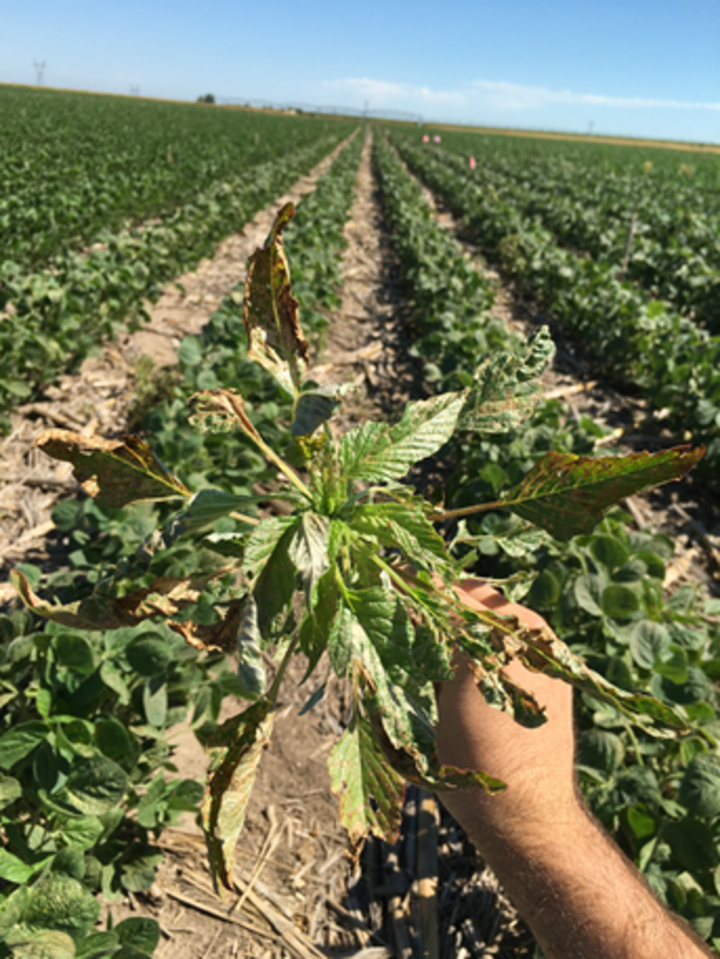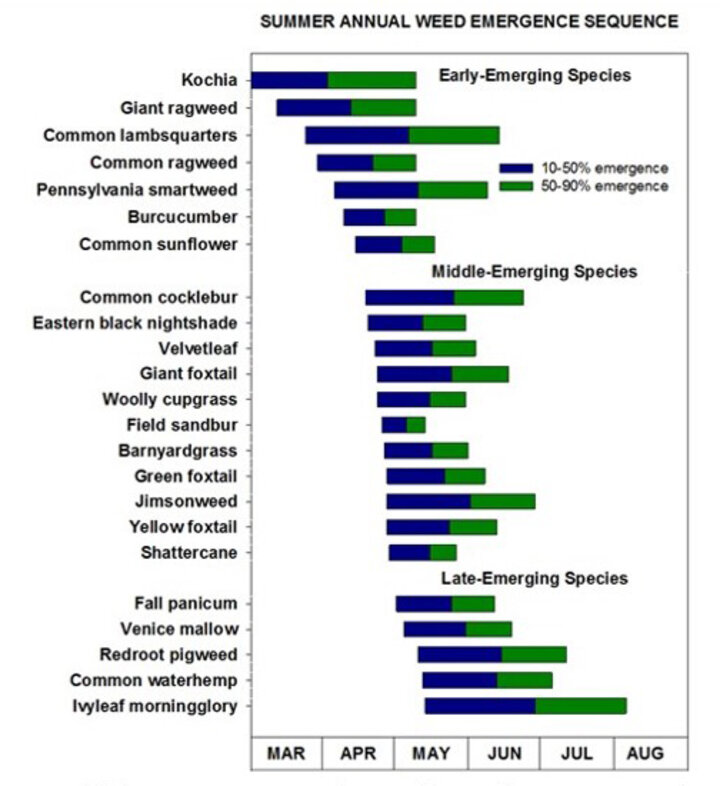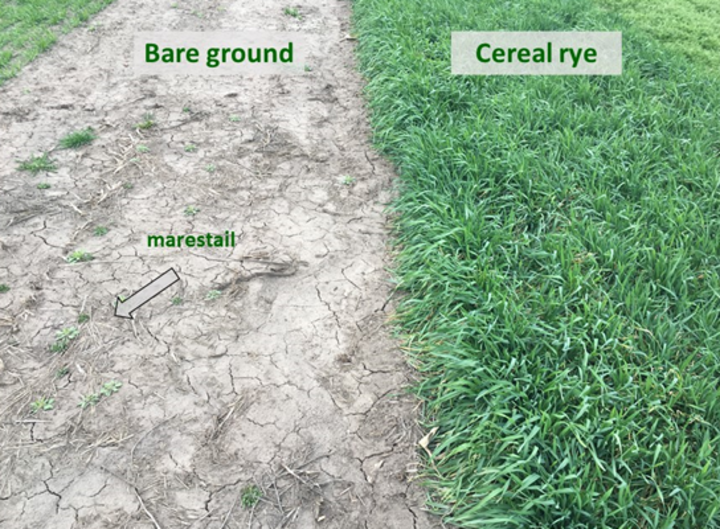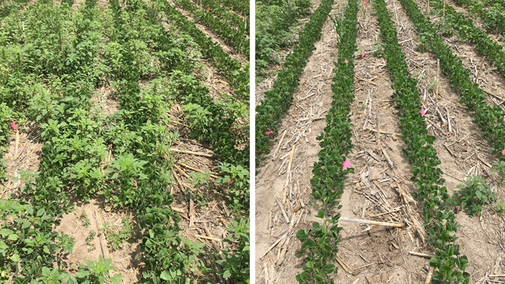As you begin developing your weed management plan, here are six key management practices and five key timings to improve control of herbicide-resistant weeds this year.
6 Key Steps
1. Remember: Timing is Everything (see box)
- Weed Emergence: Weeds emerge year-round with different species having different emergence patterns. Knowing the species present in your fields is extremely important for proper management. For instance, marestail emerges primarily in the fall with some seedlings also emerging in early spring. Kochia and giant ragweed ― the first summer annual weeds to emerge in the spring ― have a short emergence window. (Most seedlings emerge within three to four weeks.) Conversely, common waterhemp and Palmer amaranth start emerging at soybean planting time and continue to emerge until August.
- Weed Size: Herbicides for control of glyphosate-resistant weeds are most effective either before weeds emerge (soil-residual products, Figure 1) or shortly after they emerge (treat when 4 inches or less, Figure 2).

2. Take Advantage of Rotations
- Crops: The greatest crop rotation benefit comes from using crops with distinct agronomic practices such as planting/harvest dates. Rotating corn and soybeans planted and harvested at similar times and using glyphosate as the primary option for weed management for both crops does little good in terms of herbicide resistance management. Adding a crop with a different phenology (e.g., winter wheat) or one that would “force” you to select herbicides other than glyphosate (e.g., grain sorghum) would be an effective strategy. If you are using a soybean-corn rotation, rotating traits (e.g., Liberty Link) also can be effective.
- Herbicides: To reduce the selection of herbicide-resistant weeds, rotate herbicide sites of action and, when possible, use mixtures with multiple sites of action in each application. When rotating from corn to soybean, try to use herbicides with different sites of action.
5 Key Times
Fall
- This is a great time to manage winter annual weeds with herbicides.
- Adding a residual herbicide could help with early emerging spring weeds.
- Fall-planted cover crops also have potential to suppress winter annual weeds.
Early Spring
- Early scouting is important to know if any weed problems are developing (Figure 3).
- An early burndown herbicide can help you start with a clean field for planting.
- Low temperatures in early spring can affect herbicide efficacy.

Planting
- A residual herbicide product(s) is critical at planting.
- Your goal should be to Start Clean and Stay Clean.
- Narrow row spacing could help suppress weeds with earlier canopy closure.
Early Vegetative (V3-V4)
- Scout to detect any weed escapes.
- Don’t wait until weeds are 3 inches tall to plan application. If weed seedlings are present (especially Palmer amaranth), it’s time to make your post-emergence herbicide application
- Tank-mix with a residual herbicide to keep the field clean until canopy closure.
- Overlap residuals to help the field stay clean.
Late Vegetative and Reproductive
- Scout before canopy closure.
- Seedbank management is critical. One plant going to seed this year could turn into hundreds to thousands of plants next season. Adopt a “Zero-Tolerance” program.
- Take extreme action to prevent weed seed:
- hand weed,
- inter-row cultivate, or
- use a second post-emergence herbicide application.
3. Scout (Know Your Fields)
- Problem Areas: Scout your fields multiple times throughout the season, particularly fields or areas with a past history of heavy weed pressure.
- Application Efficacy: Shortly after a herbicide application, evaluate the quality of the application. By constantly scouting, unpleasant surprises can be avoided in July/August after soybeans close canopy.
4. Tackle Problems Early
- Don’t wait until your field is overrun with resistant weeds before taking action.
- Hand Pull Weeds. If you are passing by your field and notice one or two pigweeds poking through the canopy, this is a great time to hand pull and remove these weeds before they go to seed. Two plants this year could be 2,000 plants next year if left unattended.
- Treat field borders and edges before weeds have opportunity to gain a foothold within the field. This also provides opportunity to use effective herbicides that might not be available for use in soybeans.
- Spot treat with herbicides. In areas where you know a weed problem is developing, a targeted herbicide application may be effective in managing the evolution of resistance. You may not need to cover all your acres with a second or third application, but it could pay dividends on a smaller number of problem acres.
- Target any Tillage. While tillage on all your acres probably doesn’t make sense, tillage is an effective weed management tool. Using tillage on a reduced number of acres where weeds are becoming difficult to control could help manage herbicide resistance.
5. Use Herbicide Tools Effectively
- Tank-mix herbicides with multiple effective sites of action to slow the evolution of herbicide resistance. If a field has resistance to glyphosate, for example, including glyphosate in a tank-mix would not count as an effective site of action.
- Use the highest label-recommended rate. You might save money using a lower rate, but it will likely also decrease the time for resistance to occur, which may cost more money in the end.
- Proper sprayer setup is important to maximize herbicide application efficacy and reduce off-target movement of herbicides. Nozzle selection, appropriate delivery rates, boom height, sprayer speed, and appropriate adjuvants all influence herbicide efficacy.
6. Be Willing To Go On the Offensive and Try New Measures
This battle against herbicide-resistant weeds likely will require integrating some new practices on your farm. While you can’t change your whole operation overnight, you can begin to test and evaluate new options and adopt those that will work well for you. A few things you might consider using:
- Inter-row cultivation. This may be the extra push needed for very hard to manage weed populations.
- Narrower-row-spacing. Earlier canopy closure could shade out weeds earlier in the season.
- Cover crops (Figure 4). These may provide good suppression of fall-emerging winter annual weeds and early-season summer annual weeds.
- Multi-crop rotations. This practice exposes weeds to a wider range of environments and expands the potential herbicide toolbox.
- Adjustments. If a management practice doesn’t work, try something else. Don’t apply the same herbicide after a failure hoping for a different result. If a management practice does work, also try something else! Remember that diversity is a key strategy for management of herbicide resistance.

Note: This article was originally published in SoybeaNebraska Magazine, a publication of the Nebraska Soybean Association and the Nebraska Soybean Board.

